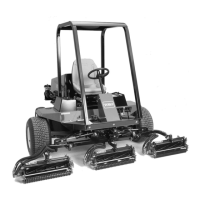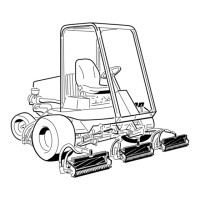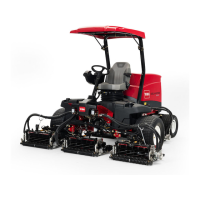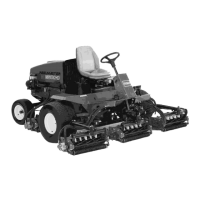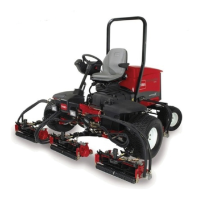Reelmaster 5010 SeriesHydraulic System (Rev. C) Page 4 -- 78
11.Disconnecthydrauliclinesfromfittingsonwheelmo-
tor. Allow lines to drain into a suitable container.
12.Put caps or plugs on disconnected lines and fittings
to prevent contamination.
13.Support wheel motor to prevent it from falling. Re-
movefour(4)locknutsfromcapscrewsthatsecuremo-
tor and brake bracket to frame.
14.Remove four (4) cap screws, brake assembly and
brake bracket from wheel motor and frame.
15.Remove wheel motor from machine.
16.Ifhydraulicfittingsaretoberemovedfromwheelmo-
tor, mark fitting orientation to allow correct assembly.
Remove fittings from motor and discard O--rings.
Installation
1. If fittings were removed from wheel motor, lubricate
andplace newO--ringstofittings.Installfittingsintomo-
torports using marks made during the removal process
toproperlyorientatefittings(seeHydraulicFittingInstal-
lationintheGeneralInformationsectionofthischapter).
2. Position wheel motor to frame. Slide brake assem-
bly, brake bracket and four (4) cap screws onto wheel
motor and frame.
3. Install and tighten four (4)lock nuts onto c ap screws
tosecuremotorandbrakebrackettoframe.Torquelock
nuts from 80 to 100 ft--lb (109 to 135 N--m).
4. Thoroughly clean wheel motor shaft and wheel hub
taper.
5. Install key into the wheel motor shaft keyslot. Align
wheel hub with key and slide wheel hub onto motor
shaft. Secure hub with lock nut.
A. On machines with Parker wheel motors, torque
lock nut from 250 to 350 ft--lb (339 to 474 N--m).
B. On machines with Eaton wheel motors, torque
lock nut from 405 to 495 ft--lb (550 to 671 N--m).
6. Remove caps or plugs from disconnected hydraulic
lines and fittings.
7. Lubricate and position new O--rings to fittings on
wheelmotor.Uselabelsplaced during the removal pro-
cesstoproperlyinstallhydrauliclinestowheelmotorfit-
tings.
8. Positionbrakecableendtobrakeactuatorlever.Se-
cure brake cable clevis to brake actuator lever with cle-
vis pin and cotter pin or spring.
9. Install front wheel to machine (see Front Wheel
Installation in the Service and Repairs section of Chap-
ter 6 -- Chassis). Make sure that lug nuts are torqued
from 70 to 90 ft--lb (95 to 122 N--m).
10.Check and adjust oil level in hydraulic tank.
IMPORTANT: Ifawheelmotorfailureoccurred,refer
to Traction Circuit Component Failure in the Gener-
alInformation section for informationregarding the
importance of removing contamination from the
traction circuit.
11.Operate machine functions slowly until air is out of
system (see Charge Hydraulic System in this section).
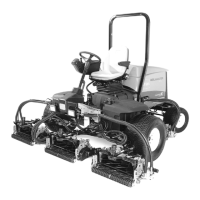
